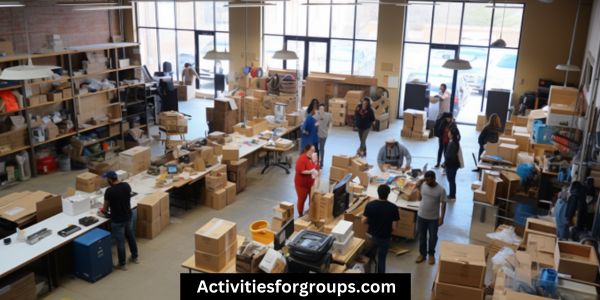Organizing group volunteer work can be a rewarding and meaningful experience, but it can also be challenging. Don’t worry – with the right resources and preparation, you can easily manage the challenges that come with taking on a group project.

Learn how to gather the necessary resources, assign roles, set goals, and monitor progress to ensure a successful outcome.
Gather Resources
Once you’ve identified the volunteer opportunity you want to organize, gathering the resources necessary to do so can be the next challenge. Delegating tasks and creating teams are key to having a successful event.
First, be sure to assess the scope of the project and the resources necessary to make it happen. This includes an estimate of the number of volunteers needed, the supplies needed, and any potential costs associated with it.
Next, consider which skills and resources your volunteers possess that can be used to organize the event. Delegating tasks to individuals with the right skills can help make the event run smoothly. It can also be beneficial to create teams to oversee different aspects of the project. This can help you stay organized and ensure that all tasks are completed in a timely manner.
Assign Roles
Once you have identified the resources needed and created teams, it’s important to assign roles and tasks in a way that allows each volunteer to contribute. A great way to do this is by dividing tasks among the volunteers, taking into account their individual strengths and interests. It’s also important to be clear and specific when assigning tasks so everyone is aware of their individual roles and responsibilities.
When assigning tasks, it’s important to take into account the motivation of the volunteers. Make sure to provide volunteers with tasks that they are passionate about and make them feel like they are making a meaningful contribution. It’s also important to recognize the contributions of volunteers by thanking them for their hard work and providing them with feedback.
| Dividing Tasks | Motivating Volunteers |
|---|---|
| Take into account individual strengths and interests | Give tasks that volunteers are passionate about |
| Be clear and specific | Recognize contributions with thanks and feedback |
| Assign roles that are manageable | Provide volunteers with meaningful work |
Set Goals

Once you have identified the resources and roles needed to successfully carry out the volunteer project, it’s important to set clear goals to ensure the team stays on track. To do this, you need to think about how to effectively share the burdens of the work that needs to be done and how to delegate tasks to the team members.
It’s also important to break down the goals into smaller, attainable objectives and to make sure everyone is aware of their individual roles and responsibilities.
When setting goals, set timelines and establish a system of communication to keep everyone informed about progress. Make sure the goals are realistic and achievable and that everyone is held accountable for meeting them. It’s also important to take into consideration potential challenges that may arise, such as scheduling conflicts or lack of resources.
Prepare for Challenges
Although it’s important to set clear goals and create an effective system of communication, it’s equally important to prepare for potential challenges that could arise when organizing group volunteer work. There are a few key steps you can take to make sure your project runs smoothly:
- Engage volunteers early. Reach out to potential volunteers and ask for their help before the project starts. This will ensure that everyone is on the same page and that they know what they’re expected to do.
- Set a detailed planning timeline. It’s important to have a timeline that outlines when tasks should be completed and when volunteers should be available. This will help to keep everyone organized and on track.
- Monitor progress. Keep a close eye on the progress of the project and be sure to check in with volunteers on a regular basis. This will allow you to identify any potential issues and address them as soon as possible.
- Make adjustments as needed. Be flexible and be willing to make changes to the timeline or other aspects of the project as needed. This will ensure that the project is completed in a timely and effective manner.
Monitor Progress

Carrying on from preparing for potential challenges, it’s important to monitor progress on a regular basis to ensure the project is running smoothly. This involves connecting all stakeholders and implementing effective communication strategies.
| Stakeholders | Communication Strategies |
|---|---|
| Volunteers | Frequent check-ins |
| Project Manager | Regular progress reports |
| Donors | Timely updates |
| Partners | Group meetings |
| Beneficiaries | Feedback surveys |
Monitoring progress requires having an open line of communication between all involved parties. This means having an understanding of each stakeholder’s roles and responsibilities. As the project manager, you should keep the volunteers, donors, partners, and beneficiaries informed by providing frequent check-ins, regular progress reports, timely updates, group meetings, and feedback surveys.
Keeping all stakeholders in the loop will help to ensure that the project is running effectively and efficiently. It also ensures that everyone is informed about any changes, shifts, or delays. By monitoring progress and staying connected, you can avoid any complications or disruptions in the project’s timeline.
Frequently Asked Questions
How Many Volunteers Are Needed to Complete the Project?
The number of volunteers you need depends on the scope of the project. Make sure to schedule volunteers accordingly and delegate tasks accordingly.
How Can I Motivate the Volunteers?
Encourage volunteers by providing engaging incentives and developing trust. Show appreciation and support to keep morale up.
What Are the Best Methods to Communicate With the Volunteers?
Coaching techniques and team dynamics can be effective methods to communicate with volunteers. Utilize these to maintain clarity and ensure everyone is on the same page.
How Should I Handle Conflicts Between Volunteers?
Handle conflicts between volunteers by engaging in open dialogue, allocating resources and time efficiently, and setting clear boundaries.
What Safety Measures Should Be Taken When Organizing Group Volunteer Work?
You should set expectations and ensure proper volunteer recruitment to ensure safety when organizing group volunteer work.
Conclusion
Organizing group volunteer work comes with its own set of challenges. By gathering resources, assigning roles, setting goals, and preparing for challenges, you can ensure that the group is successful.
By taking the time to monitor progress, you can help to ensure that any obstacles are overcome and that everyone works together to reach the goal.
Ultimately, it’s possible to make group volunteer work a rewarding and successful experience.




Leave a Reply